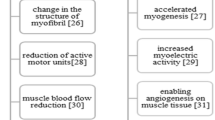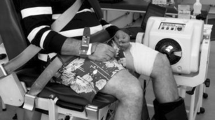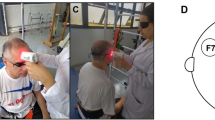Abstract
Stroke results in impairment of basic motor functions, such as muscle weakness in limbs affected by spasticity, leading to peripheral fatigue and impaired functionality. The clinical use of photobiomodulation therapy (PBMT) has provided major advances in the treatment of muscular disorders and prevention of muscle fatigue. The aim of this study was to analyze the effects of two distinct therapies in biceps spasticity of chronic hemiparetic patients. We analyzed range of elbow motion, torque, electromyography, and mean spectral frequency after 10 sessions of PBMT (Laser 100 mW, 808 nm, 159.24 J/cm2/point, 5 J/point); PBMT active or placebo was associated with exoskeleton-assisted functional treatment. A double-blind placebo-controlled sequential clinical trial was conducted with 12 healthy volunteers and 15 poststroke patients who presented upper-limb spasticity. The healthy volunteers performed only the evaluation protocol, and the poststroke volunteers participated in three consecutive phases (PBMT, PBMT + exoskeleton, placebo + PBMT) with a washout period of 4 weeks between each phase. We could observe significant increases in range of elbow motion after PBMT from 57.7 ± 14 to 84.3 ± 27.6 degrees (p < 0.001). The root mean square (RMS) values also increased after PBMT + exoskeleton from 23.2 ± 15 to 34.9 ± 21 μV (p = 0.0178). Our results suggest that the application of PBMT may contribute to an increased range of elbow motion and muscle fiber recruitment, increases in muscle strength, and, hence, to increase signal conduction on spastic muscle fibers in spastic patients.





Similar content being viewed by others
References
World Health Organization. World report on disability. [S. L.]: The World Bank, 2011, 349Http://Whqlibdoc.Who.Int/Publications/2011/9789240685215_Eng.Pdf?Ua = 1>. Acesso Em: 06/Jun/2016.
Sale P et al (2014) Effects of upper limb robot-assisted therapy on motor recovery in subacute stroke patients. J Neuroeng Rehabil 11:104
Ja N, Ka S, Rd A (1994) A dose-response relationship between amount of weight-bearing exercise and walking outcome following cerebrovascular accident. Arch Phys Med Rehabil. 75(4):399–402
Hachisuka K, Umezu Y, Ogata H (1997) Disuse muscle atrophy of lower limbs in hemiplegic patients. Arch Phys Med Rehabil. 78(1):13–18
Kl P et al (1996) Benefits of aerobic exercise after stroke. J Sports Med 21:337–346
Macko RF et al (1997) Treadmill aerobic exercise training reduces the energy expenditure and cardiovascular demands of hemiparetic gait in chronic stroke patients. Stroke 28(2):326–330
Amaral DBES et al (2017) Avaliação da funcionalidade do membro superior parético de pacientes com sequela de ave após protocolo terapia por contensão induzida. Rev Perspect on line: Biol & Saúde 7(28):81–87
Rekand T et al (2019) Botulinum toxin treatment of spasticity targeted to muscle endplates: an international, randomised, evaluatorblinded study comparing two different botulinum toxin injection strategies for the treatment of upper limb spasticity. BMJ 9(5):e024340
Dong Y et al (2017) Efficacy and safety of botulinum toxin type A for limb spasticity after stroke: a meta-analysis of randomized controlled trials. BioMed Research International 53(2):256–267
Severinsen K et al (2016) Skeletal muscle fiber characteristics and oxidative capacity in hemiparetic stroke survivors. Muscle Nerve 53(5):748–754
Calabrò RS et al (2017) Is two better than one? Muscle vibration plus robotic rehabilitation to improve upper limb spasticity and function: a pilot randomized controlled trial. PLoS ONE 12(10):e0185936
Mclaren R et al (2019) The volume and timing of upper limb movement in acute stroke rehabilitation: still room for improvement. Disabil Rehabil 5:1–6
Lopes-Martins RA, Marcos RL, Leonardo PS, Prianti AC Jr, Muscará MN, Aimbire F, Frigo L, Iversen VV, Bjordal JM (2006) Effect of low-level laser (Ga-Al-As 655 nm) on skeletal muscle fatigue induced by electrical stimulation in rats. J Appl Physiol (1985) 101(1):283–288
Lopes-Martins RA, Pazzelo Mafra F, De Nucci G (2016) Laser therapy and muscle fatigue: a promising research area. Photomed Laser Surg 34(7):273–275
Leal Junior EC et al (2011) Comparison between cold water immersion therapy (Cwit) and light emitting diode therapy (Ledt) in short-term skeletal muscle recovery after high-intensity exercise in athletes--preliminary results. Lasers Med Sci 26(4):493–501
Leal Junior EC et al (2009) Comparison between single-diode low-level laser therapy (Lllt) and led multi-diode (Cluster) therapy (Ledt) applications before high-intensity exercise. Photomed Laser Surg 27(4):617–623
Leal Junior EC et al (2008) Effect Of 655-Nm low-level laser therapy on exercise-induced skeletal muscle fatigue in humans. Photomed Laser Surg 26(5):419–424
Oron A et al (2006) Low-level laser therapy applied transcranially to rats after induction of stroke significantly reduces long-term neurological deficits. Stroke 37(10):2620–2624
Lampl Y et al (2007) Infrared laser therapy for ischemic stroke: a new treatment strategy: results of the NeuroThera Effectiveness and Safety Trial-1 (NEST-1). Stroke 38(6):1843–1849
Naeser MA et al (2011) Improved cognitive function after transcranial, light-emitting diode treatments in chronic, traumatic brain injury: two case reports. Photomed Laser Surg 29(5):351–358
Xuan W et al (2013) Transcranial low-level laser therapy improves neurological performance in traumatic brain injury in mice: effect of treatment repetition regimen. PLoS One 8(1):e53454
Xuan W et al (2014) Transcranial low-level laser therapy enhances learning, memory, and neuroprogenitor cells after traumatic brain injury in mice. J Biomed Opt 19(10):108003
Barrett DW, GONZALEZ-LIMA F (2013) Transcranial infrared laser stimulation produces beneficial cognitive and emotional effects in humans. Neuroscience 230(29):13–23
Huisa BN et al (2013) Incremental treatments with laser therapy augments good behavioral outcome in the rabbit small clot embolic stroke model. Lasers Med Sci. 28(4):1085–1089
Heo JC, Park JA, Kim DK, Lee JH (2019) Photobiomodulation (660 nm) therapy reduces oxidative stress and induces BDNF expression in the hippocampus. Sci Rep. 12 9(1):10114. https://doi.org/10.1038/s41598-019-46490-4
Karu TI, Pyatibrat LV, Afanasyeva NI (2005) Cellular effects of low power laser therapy can be mediated by nitric oxide. Lasers Surg Med. 36(4):307–314
Baroni BM et al (2010) Low-level laser therapy before eccentric exercise reduces muscle damage markers in humans. Eur J Appl Physiol. 110(4):789–796
Bjordal JM, Johnson MI, Iversen V, Aimbire F, Lopes-Martins RA (2006) Low-level laser therapy in acute pain: a systematic review of possible mechanisms of action and clinical effects in randomized placebo-controlled trials. Photomed Laser Surg. 24(2):158–168
Bjordal JM, Lopes-Martins RA, Iversen VV (2006) A randomised, placebo controlled trial of low level laser therapy for activated Achilles tendinitis with microdialysis measurement of peritendinous prostaglandin E2 concentrations. Br J Sports Med 40(1):76–80
Reis MC et al (2015) Immediate effects of low-intensity laser (808 Nm) on fatigue and strength of spastic muscle. Lasers Med Sci. 30(3):1089–1096
Neves MF et al (2016) Effects of low-level laser therapy (Lllt 808 Nm) on lower limb spastic muscle activity in chronic stroke patients. Lasers Med Sci. 31(7):1293–1300
Nordin N, Xie SQ, Wünsche B (2014) Assessment of movement quality in robot- assisted upper limb rehabilitation after stroke: a review. J Neuroeng Rehabil 12(11):137
Grimm F, Naros G, Gharabaghi A (2016) Compensation or restoration: closed-loop feedback of movement quality for assisted reach-to-grasp exercises with a multi-joint arm exoskeleton. Front Neurosci 15(10):518
Ballester BR et al (2016) Counteracting learned non-use in chronic stroke patients with reinforcement-induced movement therapy. J Neuroeng Rehabil. 9 13(1):74
Reinkensmeyer DJ et al (2016) Computational neurorehabilitation: modeling plasticity and learning to predict recovery. J Neuroeng Rehabil. 13(1):42
Leal Junior EC et al (2010) Effects of low-level laser therapy (LLLT) in the development of exercise-induced skeletal muscle fatigue and changes in biochemical markers related to postexercise recovery. J Orthop Sports Phys Ther. 40(8):524–532
de Freitas LF, Hamblin MR2 (2016) Proposed mechanisms of photobiomodulation or low-level light therapy. IEEE J Sel Top Quantum Electron 22(3). https://doi.org/10.1109/JSTQE.2016.2561201
Huang YY et al (2011) Biphasic dose response in low level light therapy - an update. Dose Response 9(4):602–618
Wang X et al (2016) Interplay between up-regulation of cytochrome-c-oxidase and hemoglobin oxygenation induced by near-infrared laser. Sci Rep 6:30540
Wang X et al (2017) Up-regulation of cerebral cytochrome-c-oxidase and hemodynamics by transcranial infrared laser stimulation: a broadband near-infrared spectroscopy study. J Cereb Blood Flow Metab 37(12):3789–3802
Ferraresi C, Hamblin MR, Parizotto NA (2012) Low-level laser (light) therapy (Tlbi) on muscle tissue: performance, fatigue and repair benefited by the power of light. Photonics Lasers Med. 1(4):267–286
De Almeida P et al (2012) Red (660 nm) and infrared (830 nm) low-level laser therapy in skeletal muscle fatigue in humans: what is better? Lasers Med Sci 27:453–458
Lopes-Martins RA et al (2006) Effect of low-level laser (Ga-Al-As 655 Nm) on skeletal muscle fatigue induced by electrical stimulation in rats. J Appl Physiol (1985). 101(1):283–288
Lopes-Martins RAB, Marcos RL, Leal-Junior ECP, Bjordal JM (2018) Low-level laser therapy and world association for laser therapy dosage recommendations in musculoskeletal disorders and injuries. Photomed Laser Surg. 36(9):457–459
Ramos L et al (2018) Characterization of skeletal muscle strain lesion induced by stretching in rats: effects of laser photobiomodulation. Photomed Laser Surg. 36(9):460–467
Naterstad IF et al (2018) Comparison of photobiomodulation and anti-inflammatory drugs on tissue repair on collagenase-induced Achilles tendon inflammation in rats. Photomed Laser Surg. 36(3):137–145
Acknowledgments
The authors would like to thank CAPES (PE 030/2008) and FINEP/MCTIC (01.13.0275.00) for the financial support. The authors also thank FAPESP GRANTS CEPOF 13/07276-1.
Author information
Authors and Affiliations
Corresponding author
Ethics declarations
The protocol was approved by the Ethics and Research Committee of the University of Vale do Paraíba, Brazil, and later registered in ClinicalTrials. All procedures will be in accordance with the WMA Declaration of Helsinki.
Conflict of interests
The authors declare that they have no conflict of interests.
Additional information
Publisher’s note
Springer Nature remains neutral with regard to jurisdictional claims in published maps and institutional affiliations.
Rights and permissions
About this article
Cite this article
das Neves, M.F., Aleixo, D.C., Mendes, I.S. et al. Long-term analyses of spastic muscle behavior in chronic poststroke patients after near-infrared low-level laser therapy (808 nm): a double-blinded placebo-controlled clinical trial. Lasers Med Sci 35, 1459–1467 (2020). https://doi.org/10.1007/s10103-019-02920-3
Received:
Accepted:
Published:
Issue Date:
DOI: https://doi.org/10.1007/s10103-019-02920-3




